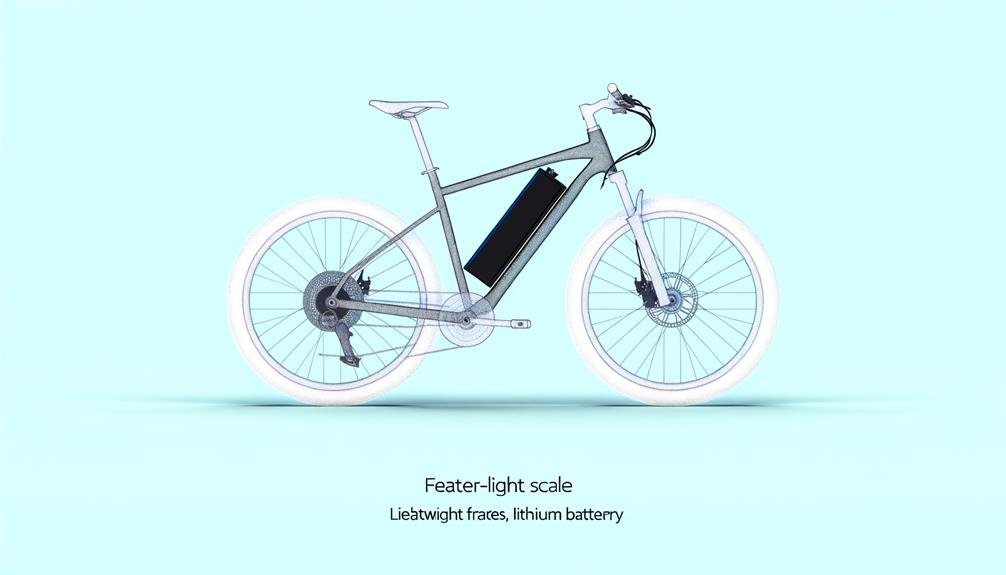Charles Miller is a veteran bike enthusiast with over 12 years of experience dealing with bikes as a mechanic. Despite immense love and expertise for...
In the realm of electric bikes, the weight of the bike can be a pivotal factor in determining its performance, maneuverability, and ease of transport. Among the various brands in this sector, Trek is a prominent player known for its diverse range of e-bikes.
When we look at Trek electric bikes, we find a significant variation in weight across different models, primarily due to the diversity in their components and design specifications. While the lightest Trek e-bikes may weigh as little as 27.45 lbs, some of the heavier models can weigh considerably more.
This variety in weight raises a few intriguing questions: How does the weight of an e-bike affect its performance? What factors contribute to the weight of a Trek electric bike? And ultimately, how can this information assist potential buyers in making an informed choice?
Let us explore these questions further.
Key Takeaways
- The weight of electric bikes can significantly impact their performance, maneuverability, and ease of transport.
- Trek electric bikes have a range of weights, with the lightest models weighing as little as 27.45 lbs.
- Factors influencing e-bike weight include frame material, components, suspension design, and the electric drive system.
- The weight of an e-bike can affect its overall performance, including motor efficiency, battery life, and structural components.
Understanding Electric Bike Weight
To comprehend the weight of electric bikes, it's crucial to examine the Trek E-Caliber line, where the top model, the E-Caliber 9.9 XX1 AXS, tips the scale at 15.75 kg (34.72 lb), primarily due to its carbon frame, short travel suspension, and lightweight components. This understanding of electric bike weight is essential to appreciate the ingenuity and engineering behind the Trek electric bikes, which are designed to balance performance with manageability.
The E-Caliber 9.9 XX1 AXS is an example of how the total weight of an electric bike can be optimized for specific riding styles. It's designed for cross country-style riding, which demands a lighter, more agile bike. To achieve this, the bike utilizes a carbon frame and wheels, short travel suspension (120 mm front and 60 mm rear), and lightweight components. Without the Fazua unit – a significant component of the bike's electric system – the bike weighs just 12.45 kg (27.45 lb).
Understanding 'how much does a Trek electric bike weigh?' becomes an exploration of the symbiosis between design, material choice, and the intended use of the bike. This detailed analysis offers valuable insights into the electric bike market and the innovative solutions manufacturers like Trek employ to meet diverse rider needs.
Weight of Different Trek Models
Examining various models across the Trek electric bike range reveals a strategic balance of weight, performance, and rider capacity, each tailored to meet specific user requirements and riding styles.
The weight of different Trek models varies, with the E-Caliber 9.9 XX1 AXS, Trek's top-of-the-line electric bike, weighing in at 15.75 kg (34.72 lb). Remarkably, without the Fazua unit, this bike weighs just 12.45 kg (27.45 lb), demonstrating Trek's commitment to versatility and adaptability.
Meanwhile, the Trek Allant Plus 7 and the Trek Verve Plus 3, while heavier, are capable of carrying larger loads. With a maximum rated weight of around 275 lbs and 300 lbs respectively, these models cater to riders of all sizes. However, it's crucial to note that the weight limit includes the bike itself, a factor that could be a concern for heavier riders.
The weight distribution between the rider and the Trek E-bike can influence the motor, battery life, and spokes, especially in mountain bikes. Trek's thoughtful design approach ensures a balance between durability and performance, inviting all riders to the world of electric bike cycling.
Factors Influencing E-Bike Weight

Several factors come into play when considering the weight of a Trek electric bike. These factors include the frame material, components, suspension design, electric drive system, and the purpose and riding style for which the bike was designed.
A bike's frame material can significantly affect the weight. Carbon frames are typically lighter than alloy frames.
The components of the bike, such as hydraulic disc brakes or a bike rack, also influence the weight. Lighter components contribute to a lower overall weight.
The suspension design is another crucial factor. Mountain bikes, especially electric mountain bikes, often feature more substantial, longer-travel suspensions, which can increase weight.
The weight of the electric drive system, including the batteries, also significantly influences the e-bike's weight. E-bikes with a more extended battery life would likely weigh more, as larger batteries are typically heavier.
The bike's intended purpose and riding style also play a role. For instance, an e-bike designed for easy maneuvering in city traffic might have a lower weight limit of around 35 kilograms, compared to a robust mountain bike.
Therefore, when choosing your new e-bike, be sure to check the specifications carefully to understand how these factors influence the bike's weight. This will ensure that the bike meets your needs and riding style.
Weight and E-Bike Performance
Understanding the interplay between an e-bike's weight and its overall performance necessitates a close look at various elements such as the motor, battery life, and structural components. The weight of the rider and the bike can impact these components, potentially affecting the overall performance.
For instance, top-of-the-line Trek e-bike models like E-Caliber 9.9 XX1 AXS, weighing 15.75 kg with the Fazua unit and 12.45 kg without it, use lightweight components and carbon frames to optimize performance.
Furthermore, the maximum weight limits for models such as Allant Plus 7 and Verve Plus 3 are approximately 275 lbs and 300 lbs, respectively. These limits include the bike's weight, underscoring the importance of weight management in maintaining the e-bike's functionality and longevity.
Structural integrity is another significant aspect. Finite element analysis is often used to evaluate e-bike frames and components, especially under shock loading scenarios like jumping curbs or hitting potholes.
Engaging with the Trek community and experienced riders can offer insights into performance under different weight conditions, aiding in optimizing performance and longevity.
Transporting Your Trek E-Bike

Drawing from the insights gained on weight management in e-bikes, it becomes crucial to consider these aspects when planning to transport your Trek E-Bike.
The weight of the bike, with the E-Caliber 9.9 XX1 AXS model weighing 15.75 kg (34.72 lb), is a vital consideration when determining the feasibility of transportation. Depending on the mode of transport, it's essential to verify that its weight limits can accommodate your e-bike, especially if you opt to keep the Fazua battery and motor attached.
Lightening the load is also a possibility:
- The detachable Fazua unit can be removed to reduce the bike's weight to 12.45 kg (27.45 lb), making it more manageable.
- The bike's lightweight design, featuring a carbon frame and wheels, aids in easier transportation.
Weight Limitations and Safety
In the realm of e-biking, adherence to weight limitations is a critical component of ensuring both the safety of the rider and the optimal performance of the Trek E-Bike. Overloading the bicycle not only places undue stress on the frame and components, potentially leading to mechanical failures, but also impacts the bike's handling, braking efficiency, and overall performance.
It's crucial to consider not just the weight of the rider, but also that of any cargo or accessories when determining the total load on the bike. The cumulative weight can influence the motor's output, battery life, and even the bike's longevity.
Engaging with experienced riders, consulting with the manufacturer, or participating in community forums can provide invaluable insights into how weight affects your Trek E-Bike. Understanding these nuances allows you to make informed decisions about your e-bike's usage, contributing to your safety and enhancing your riding experience.
Always remember, when it comes to e-biking, your awareness and respect for weight limitations directly reflect your commitment to safety and performance.
Lightest Trek Electric Bikes

The E-Caliber 9.9 XX1 AXS is one of the lightest full-suspension electric mountain bikes offered by Trek. It weighs only 15.75 kg or 34.72 lb, making it extremely lightweight. When the Fazua unit is removed, the weight decreases even further to just 12.45 kg or 27.45 lb, highlighting the bike's flexible and lightweight design. This reduced weight has a significant impact on the bike's performance, especially when it comes to cross country-style riding.
Top Lightweight Models
Among the lightest models of Trek electric bikes, the top-of-the-line E-Caliber 9.9 XX1 AXS stands out with its remarkably low weight of just 15.75 kg (34.72 lb), which drops further to 12.45 kg (27.45 lb) when the Fazua unit is removed.
This impressive reduction in weight is largely attributable to the carbon frame and wheels, known for their strength and lightweight properties. The use of a carbon frame and wheels significantly contributes to the overall weight reduction of the bike.
Additionally, the E-Caliber 9.9 XX1 AXS features short travel suspension, a feature that reduces weight while still providing sufficient comfort and control for cross-country riding. This means that the bike is optimized for lightweight maneuverability without compromising on ride quality.
Furthermore, the bike is equipped with lightweight components that do not compromise on performance or durability. These components are carefully selected to maintain the bike's lightweight nature while ensuring it can handle the demands of various riding conditions.
Weight Impact on Performance
Shedding weight while maintaining robust performance, the E-Caliber 9.9 XX1 AXS, Trek's top-of-the-line electric bike, serves as a quintessential example of how reduced weight can significantly enhance the riding experience. Weighing just 15.75 kg, its lightness is attributed to the carbon frame and wheels, short travel suspension, and lightweight components.
When stripped of the Fazua unit, the E-Caliber weighs a mere 12.45 kg, a remarkable achievement for an eMTB. This reduced weight, coupled with a lower travel suspension of 120 mm front and 60 mm rear, results in a nimble and responsive ride.
This combination of lightness and performance makes the E-Caliber an all-purpose eMTB, suitable for a wide range of trails, establishing a new benchmark for electric mountain bikes.
Frequently Asked Questions
Does Trek Have a Lightweight Ebike?
Yes, Trek's innovation in E-bikes is exemplified by their E-Caliber line. Through weight reduction strategies like carbon frames and wheels, the high-end E-Caliber 9.9 XX1 AXS only weighs 15.75 kg.
Are Electric Bikes Heavy to Lift?
While electric bikes may be heavier than traditional bicycles, proper lifting techniques can mitigate portability concerns. Although the weight varies, with some models like the Trek E-Caliber weighing around 15.75 kg, they are manageable with caution.
How Much Should an Electric Bike Weigh?
The weight of an electric bike should balance portability concerns with performance correlation. The bike's weight impacts maneuverability, while also influencing battery life. Therefore, an optimal weight ensures enhanced performance without compromising on ease of handling.
How Much Does the Trek Dual Sport 2 Electric Weight?
The Trek Dual Sport 2 electric bike, with its robust frame materials and efficient suspension system, offers excellent sport performance. However, its weight can vary depending on battery lifespan and additional features.
Conclusion
In conclusion, the weight of a Trek electric bike varies based on the specific model and components used. Factors such as the presence of a Fazua electric drive system, the material of the frame and wheels, and other lightweight components significantly influence this weight.
These variations play a crucial role in the bike's performance, transportation ease, and safety. For instance, the lightweight E-Caliber 9.9 XX1 AXS model, weighing 15.75 kg with the Fazua unit, exemplifies this.

Charles Miller is a veteran bike enthusiast with over 12 years of experience dealing with bikes as a mechanic. Despite immense love and expertise for his Tacoma, he rides his Trek Ebike more. Anytime you meet him, you’ll either hear him talking about Bikes, or writing about all things bikes and cars on this blog.
More Posts


